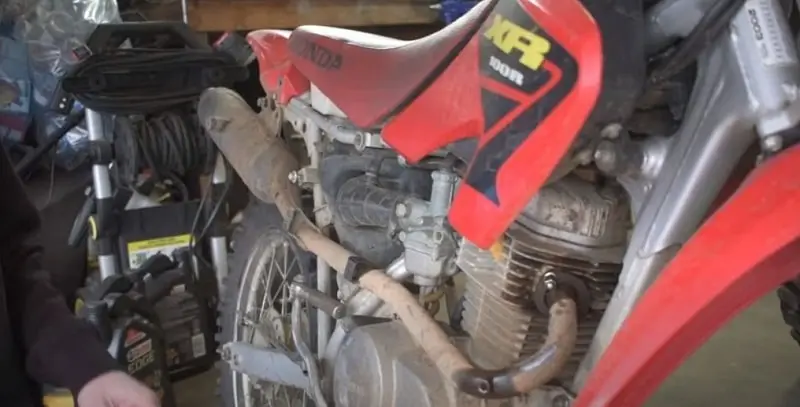Are you tired of your bike’s exhaust pipe looking worn out and underperforming? Well, I’ve got some good news for you.
In this article, I’m going to show you how to revive your dirt bike’s exhaust and give it a performance boost like never before!
Imagine the thrill of riding your bike with a perfectly maintained exhaust pipe. Not only will it improve the overall look of your bike, but it will also increase its resale value. Plus, a well-functioning exhaust pipe ensures your engine runs smoothly and efficiently.
But that’s not all. By repairing your exhaust pipe, you’ll also get to enjoy a more powerful and satisfying exhaust sound. Who doesn’t want their bike to roar like a beast?
So, get ready to roll up your sleeves and follow along as I guide you through the steps to repair and enhance your dirt bike’s exhaust. Trust me, it’s easier than you think. Let’s get revved up and make your bike shine again!
Key Takeaways
- Repairing the dirt bike exhaust pipe is important for increasing performance and resale value, improving the bike’s overall look, preventing further damage, enhancing the exhaust sound, and ensuring the engine’s proper functioning.
- The steps to repair a dirt bike exhaust pipe include plugging the ends of the pipe, heating the trouble spots to remove dents, sanding the pipe to smooth out rough areas, and choosing the right heat-resistant paint for durability.
- Safety precautions should be taken, such as seeking professional help if not mechanically inclined, wearing proper protective clothing, and following safety guidelines to avoid accidents.
Steps to Repair
I’ll start by discussing the steps to repair a dirt bike exhaust pipe. Repairing your exhaust pipe is essential for improving your bike’s performance and overall look.
To begin, you need to plug the ends of the pipe. Find or create plugs that can block both ends securely. You can use a bolt and nut system with a rubber bush to ensure a tight seal.
One of the plugs should have an air valve for pressure application. However, it is crucial to be cautious of excessive air pressure to avoid accidents.
Next, heat the trouble spots using a gas torch. Apply direct heat until the area turns red hot, but be careful not to burn a hole through the pipe. While heating, carefully apply air pressure to watch the dents pop out.
After removing the dents, sand the pipe to smooth out any rough or uneven areas. This step prepares the surface for a paint job.
Choose a heat-resistant paint for durability, and consider using matte black for a sleek look. Ensure the paint adheres well to the pipe by following the manufacturer’s instructions for application.

Safety Precautions
Before starting the procedure, it’s important to prioritize safety by wearing appropriate protective clothing and following recommended guidelines. Here are some key safety precautions to keep in mind:
- Seek professional help if you’re not mechanically inclined. It’s better to have an expert handle the repair if you’re unsure of what you’re doing.
- Be cautious of potential dangers involved. Working with heat and pressure can be risky, so always be cautious and aware of your surroundings.
- Follow safety guidelines and recommendations. These guidelines exist for a reason and can help prevent accidents and injuries.
- Take necessary precautions to avoid accidents. This includes using the right tools, working in a well-ventilated area, and being mindful of any potential hazards.
Remember, the goal is to repair and enhance your dirt bike’s exhaust, but your safety should always come first. So, make sure to take the necessary precautions to protect yourself during the process.
Frequently Asked Questions
What common signs indicate a dirt bike exhaust pipe needs repair?
Some common signs that indicate a dirt bike exhaust pipe needs repair include the following:
- Decreased performance
- A loud and abnormal exhaust sound
- Visible damage, such as dents or holes
- Excessive smoke or fumes coming from the pipe
If you notice any leaks or a decrease in power output, these can also be indicators of a damaged exhaust pipe.
It’s important to address these issues promptly to prevent further damage and ensure optimal dirt bike performance.
Can I repair a dirt bike exhaust pipe without professional help?
Yes, you can repair a dirt bike exhaust pipe without professional help. By following the steps outlined earlier, you can successfully fix the pipe and enhance its performance.
Plugging the ends, heating the trouble spots, sanding the pipe, and choosing the right paint are all important steps in the process.
However, taking safety precautions and being mindful of potential dangers is crucial. If you’re not mechanically inclined, it may be best to seek professional assistance.
How often should I check and repair my dirt bike exhaust pipe?
I should regularly check and repair my dirt bike exhaust pipe to ensure proper functioning and prevent further damage. The frequency of these checks depends on the usage and condition of the bike.
It’s recommended to inspect the exhaust pipe every few rides or at least once a month. Regular maintenance will help identify any issues early on and prevent major problems.
If I notice any dents, leaks, or unusual sounds, it’s essential to address them promptly.
What are some alternative methods to repair a dirt bike exhaust pipe?
While there are various methods to repair a dirt bike exhaust pipe, it’s important to consider safety and effectiveness.
One alternative method is using a high-temperature epoxy or sealant to patch up small cracks or holes. However, this may only offer a temporary fix and might not be as durable as other repair methods.
Another option is welding, which can provide a more permanent solution. However, a professional should do welding to ensure proper technique and prevent further damage to the pipe.
Are there any specific maintenance tips to prevent dirt bike exhaust pipe damage?
To prevent damage to your dirt bike exhaust pipe, you can follow a few maintenance tips.
Firstly, make sure to regularly inspect the pipe for any signs of wear or damage. This includes checking for dents, cracks, or loose fittings.
Also, avoid riding your bike through deep water or mud, which can cause corrosion.
Lastly, be mindful of the heat generated by the engine and exhaust system, as excessive heat can warp or damage the pipe.
Previous Article: How To Adjust Your Dirt Bike Rear Shock Absorber
Next Article: Dirt Bike Swing Arm Maintenance

